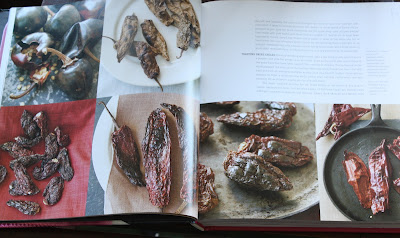A place at Naomi Andrade-Smith's table is something you never forget. Around here, her restaurant, Villa Victoria, is the stuff of legend. We met shortly before her restaurant closed, and quickly put together a finale dinner, sharing the table with chefs and writers for one last hurrah. In subsequent weeks, she sold off her equipment and the last of her tamale inventory. Poof! My source for amazing Mexican was out of business.
Craving those richly layered flavors, I consulted numerous cookbooks, and attempted to make my own Mexican spread. Nothing compared to Naomi's food. In desperation, I called her. Short of showing up on her doorstep for dinner and begging for cooking classes (she wasn't interested), what could I do?
Like Moses on the mount delivering the 10 Commandments, Naomi simply said, "Get Roberto's book."
Then, the only book published by Roberto Santibanez was the seminal, Rosa's New Mexican Table.
Shortly after that conversation, I learned Roberto had a new book coming out. And as good luck would have it, his publisher reached out to me. "Would you like a copy?"
Truly Mexican arrived and I can honestly say, I've never attacked a book so thoroughly. The first week, I made eight recipes! Each success led to another, and another. I no longer go out for Mexican food. Armed with this book, really...why bother? This is better.
While Truly Mexican includes terrific recipes, the advantages go far beyond that. Roberto Santibanez is both a chef and restaurateur, but Amy at the Culinary Institute of America is quick to point out, he's also a terrific instructor. (Santibanez occasionally teaches at the CIA.) Fortunately, for us, his clear, concise teaching style is reflected on the page.
Dried chiles come in a number of different varieties. Dutifully following a recipe and shopping for chiles is a mind boggling experience, and in previous attempts, quickly landed me in uneasy territory. Truly Mexican includes not only a photo of each chile, but a handy guide:
Inside, there's a two page Excel-style chart, listing each chile's name, the average size and weight, flavor notes, heat level, recommendations about deseeding/deveigning before toasting (some yes, others...it depends), directions on toasting each chile variety, and other notes.
My geekdom knows no bounds. I made flash cards with a chile photo on the front, and the description on the back. And then proceeded to buy every chile in the book.
When my friend Kathy bought this book, she said in astonishment, "Geez! How many salsa recipes do you need?" Here's where we differ. When I'm on the hunt for a salsa recipe, I don't want to flip through 10 books, or cobble together recipes from 10 websites. Here, in one place, is enough variety to keep me busy for a very long time. I like that. Spanning both fresh and cooked salsa, you'll find the usual suspects including pico de gallo and tomatillo to more unusual varieties like roasted pineapple (excellent on fish and seafood).
The guacamole chapter is shorter than the salsa chapter, but the recipes I've tried, set new benchmarks in guacamole land. Both the classic guacamole and Santibanez's seafood guacamole were right on the mark, and frequently repeated in our house.
Adobos. The subtitle of this chapter says it all: "Simple purees with soulful applications". Adobos are used as marinades or form the base of sauces and braising liquids, and serve as the workhorse for a number of recipes in the book. First you make the adobo, then, for example, you add meat, aromatics, and liquid for a braise, as in the Pork in Adobo.
A tip from me to you: double your adobo recipe (there are 5 to chose from)...and put half in the freezer. While many of the recipes are long, slow braises, armed with the pre-made adobo, you're half way there. Or, for a quick weeknight meal, rub the adobo over fish or steaks and grill. Voila! Long and slow or quick and fast, once you've got a stash of adobo on hand...the choice is yours.
Another feature I love about this book...just when I start to panic, there's a useful set of photos, as with this set from the tamale recipe. Pork, chicken, or beef tossed in a lusty adobo or mole sauce make terrific tamale fillings, and photos walk you through the trickiest part of the tamale-making process.
Among a handful of side dishes, Truly Mexican includes four different recipes for beans, and three for rice (white, red, and green). While beans and rice appear to be humble--and often forgettable--sides, here, Santibanez manages to elevate them to new heights. The green rice with poblano chiles? Hauntingly delicious.
.
.
Tying all the separate components together is a chapter called: More Ideas For Using Mexican Sauces. Among the recipes, you'll find the familiar steak, chicken, shrimp, and carnita tacos, tamales, chilaquiles, and enchiladas. Pictured above: Enchiladas with Mole Poblano.
While the publisher sent me my first copy of Truly Mexican, I'm already on my second copy. Somewhere along my wayward travels, my original copy was lost or stolen. By then, that book was already the backbone of my "essential" cookbook collection. When finally I settled into my new home, Truly Mexican was my very first purchase.
I still pine for Naomi's food, but thanks to Roberto, I won't be beating down her door anytime soon.
While the publisher sent me my first copy of Truly Mexican, I'm already on my second copy. Somewhere along my wayward travels, my original copy was lost or stolen. By then, that book was already the backbone of my "essential" cookbook collection. When finally I settled into my new home, Truly Mexican was my very first purchase.
I still pine for Naomi's food, but thanks to Roberto, I won't be beating down her door anytime soon.














